Abstract
The clinical course and laboratory diagnosis of peritonitis in patients undergoing continuous ambulatory peritoneal dialysis was studied in 32 consecutive episodes. Peritonitis was associated with a failure in aseptic technique in eight episodes and with an exit-site infection in four episodes. Intraperitoneal vancomycin and ceftazidime were safe, effective, and convenient. Most patients administered their antibiotics at home, and symptoms usually resolved by day 4. Culture of the deposit obtained by centrifugation of 50 ml of effluent after leukocyte lysis provided the best rate of recovery (84% culture positive) but was technically demanding. Filtration of the same volume without leukocyte lysis was simple to perform and almost as effective. Enrichment was less satisfactory (65% culture positive) owing to the presence of antibiotic or infection with fastidious microorganisms. Culture of 50 ml of effluent after concentration by a commonly used laboratory technique, centrifugation without leukocyte lysis, performed poorly (59% culture positive at 48 h), as this method caused sequestration and death of microorganisms within the leukocytes. Culture of nearly 1 liter of effluent from 33 asymptomatic patients by the same techniques yielded no microorganisms.
Full text
PDF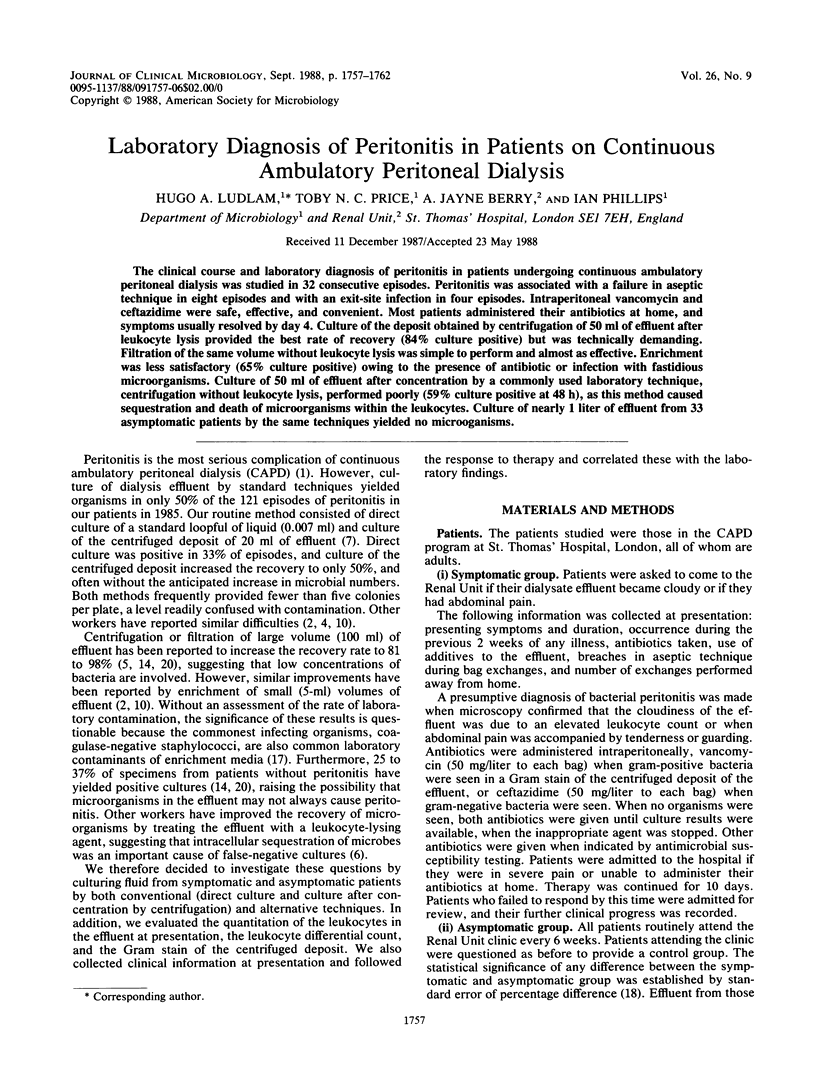
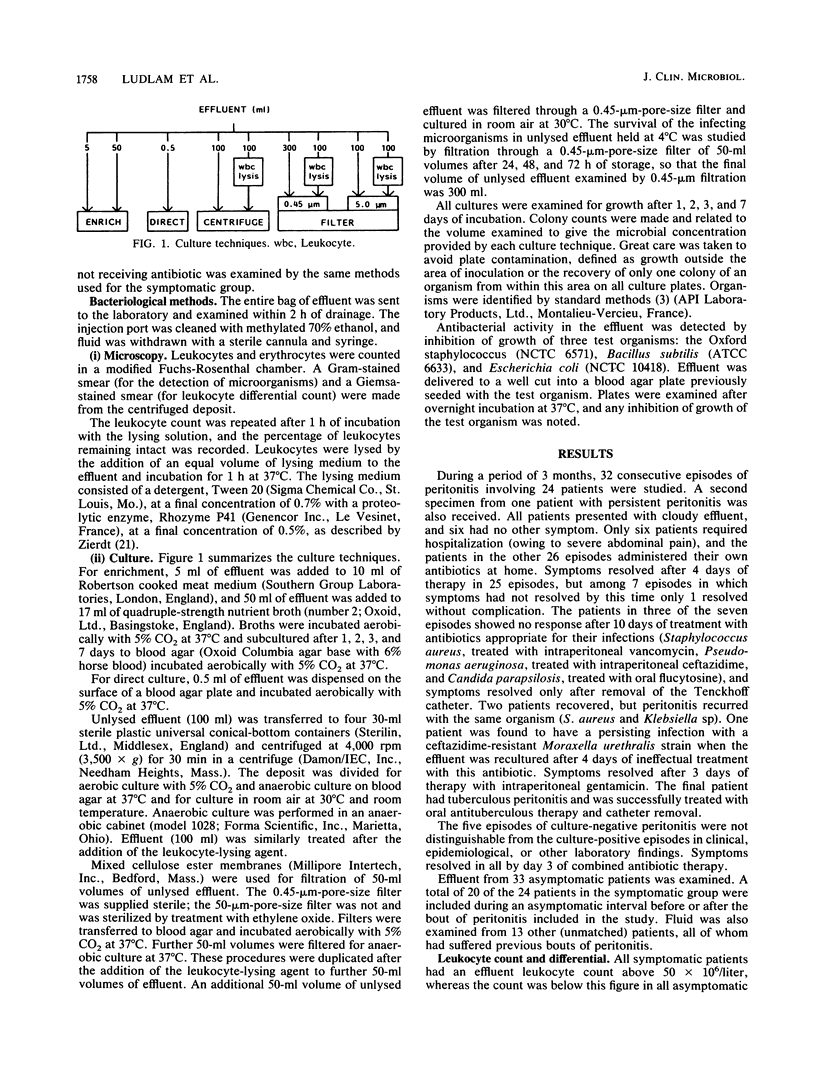
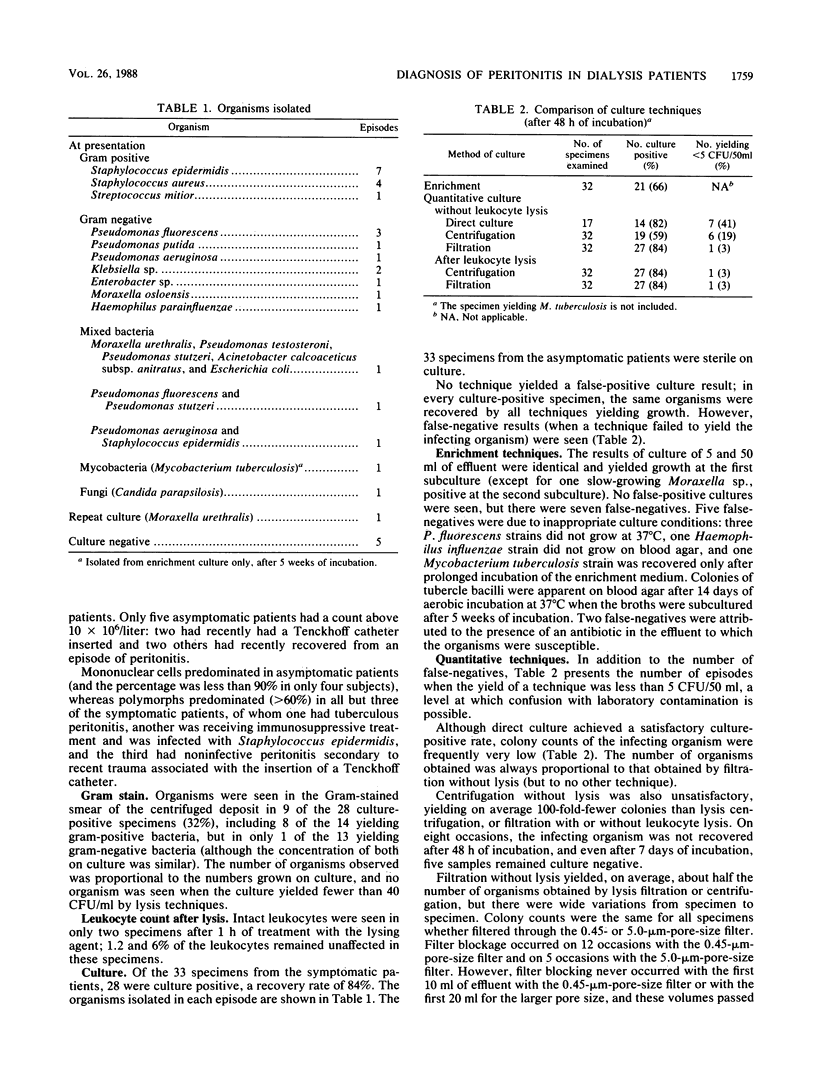
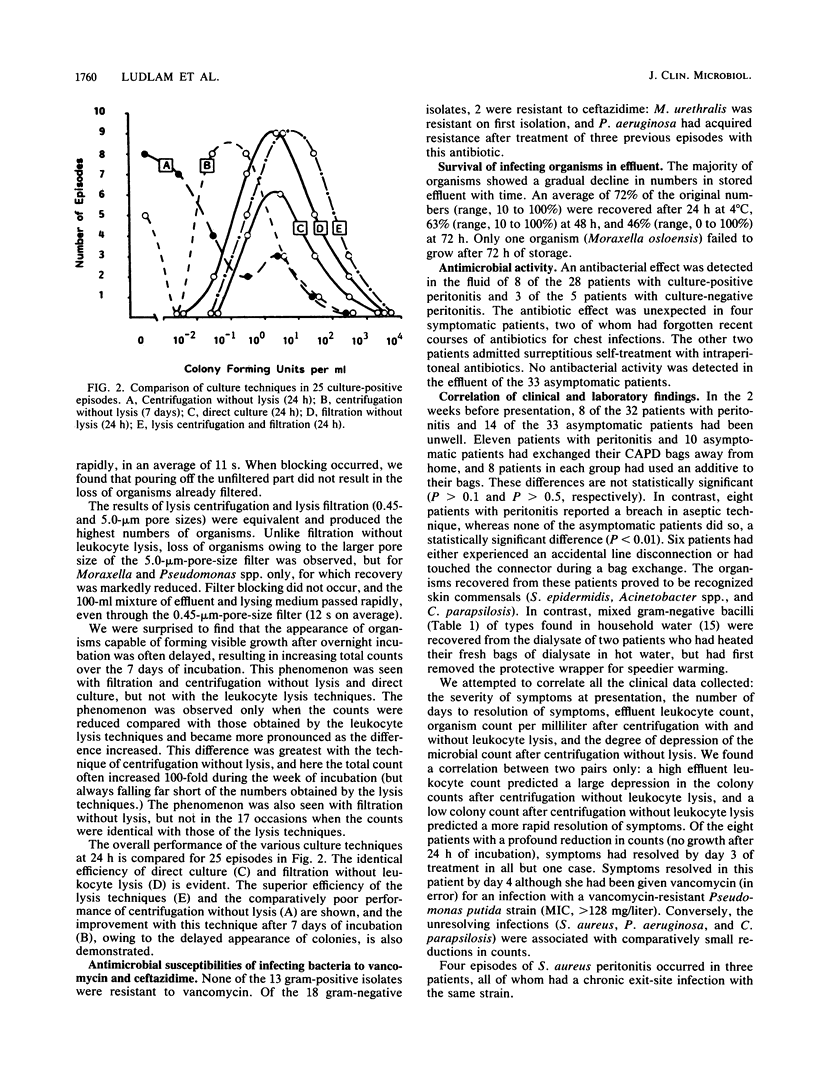
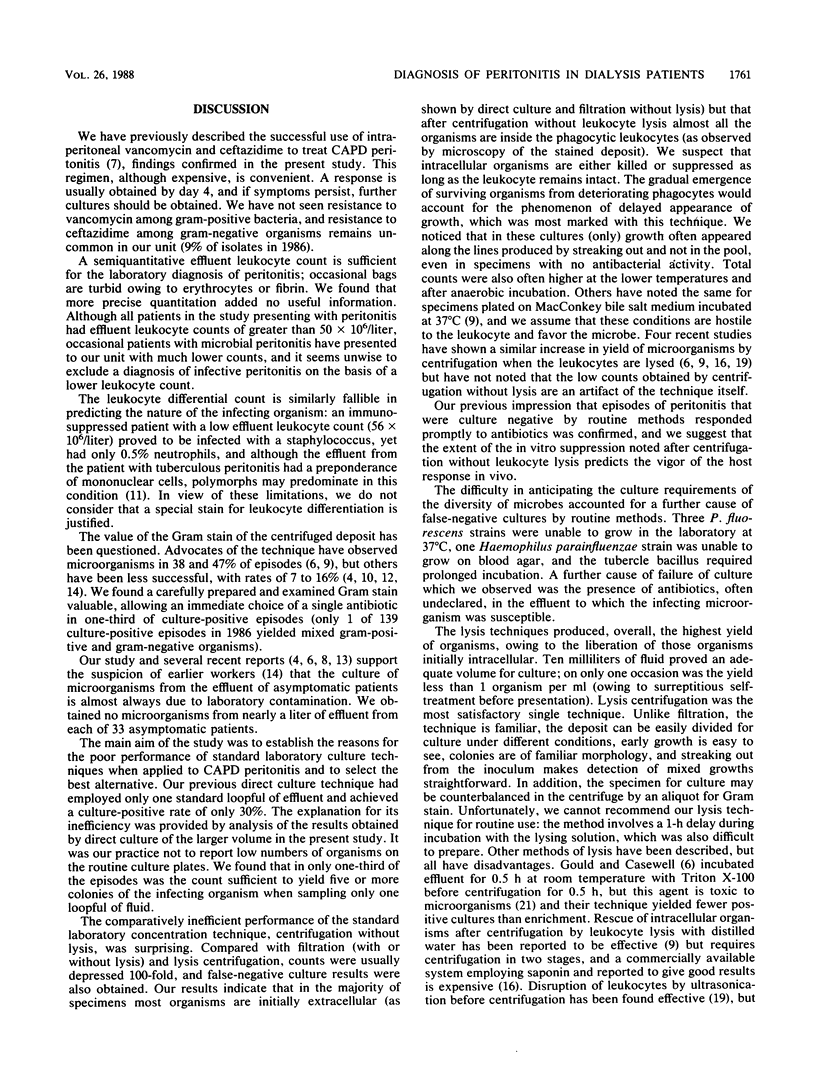
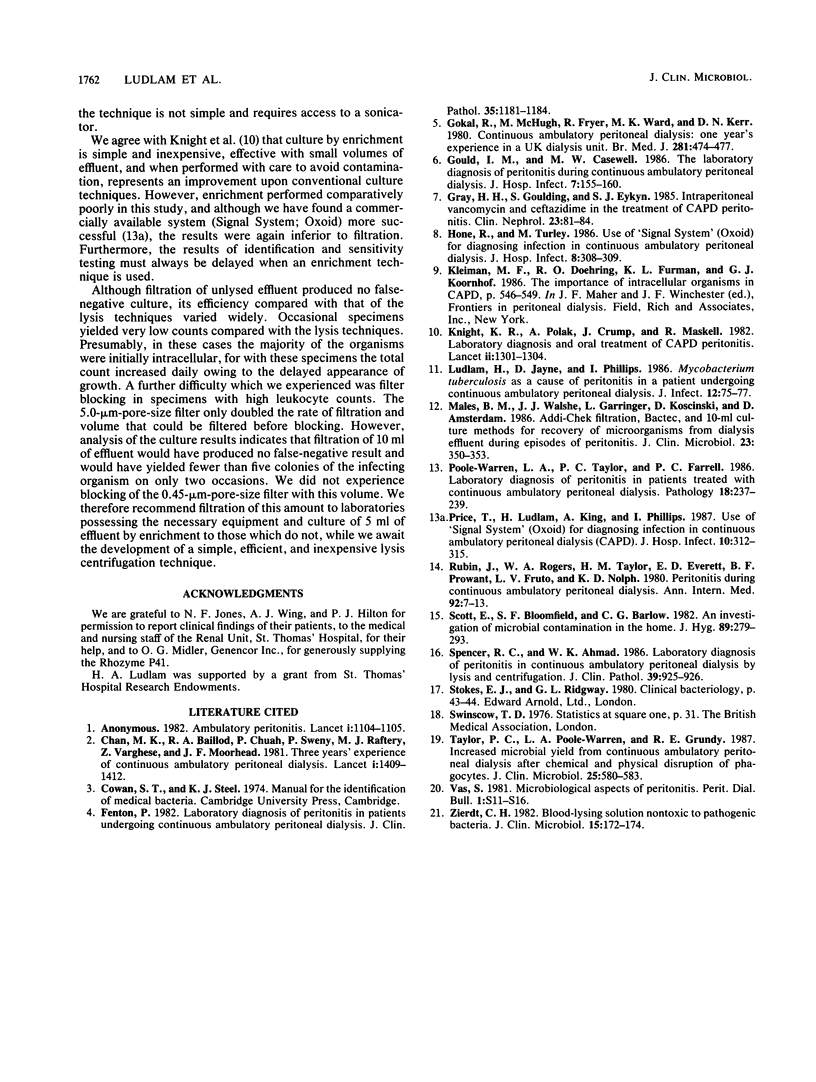
Selected References
These references are in PubMed. This may not be the complete list of references from this article.
- Chan M. K., Baillod R. A., Chuah P., Sweny P., Raftery M. J., Varghese Z., Moorhead J. F. Three years' experience of continuous ambulatory peritoneal dialysis. Lancet. 1981 Jun 27;1(8235):1409–1412. doi: 10.1016/s0140-6736(81)92582-4. [DOI] [PubMed] [Google Scholar]
- Fenton P. Laboratory diagnosis of peritonitis in patients undergoing continuous ambulatory peritoneal dialysis. J Clin Pathol. 1982 Nov;35(11):1181–1184. doi: 10.1136/jcp.35.11.1181. [DOI] [PMC free article] [PubMed] [Google Scholar]
- Gokal R., McHugh M., Fryer R., Ward M. K., Kerr D. N. Continuous ambulatory peritoneal dialysis: one year's experience in a UK dialysis unit. Br Med J. 1980 Aug 16;281(6238):474–477. doi: 10.1136/bmj.281.6238.474. [DOI] [PMC free article] [PubMed] [Google Scholar]
- Gould I. M., Casewell M. W. The laboratory diagnosis of peritonitis during continuous ambulatory peritoneal dialysis. J Hosp Infect. 1986 Mar;7(2):155–160. doi: 10.1016/0195-6701(86)90058-7. [DOI] [PubMed] [Google Scholar]
- Gray H. H., Goulding S., Eykyn S. J. Intraperitoneal vancomycin and ceftazidime in the treatment of CAPD peritonitis. Clin Nephrol. 1985 Feb;23(2):81–84. [PubMed] [Google Scholar]
- Hone R., Turley M. Use of 'Signal System' (Oxoid) for diagnosing infection in continuous ambulatory peritoneal dialysis. J Hosp Infect. 1986 Nov;8(3):308–309. doi: 10.1016/0195-6701(86)90130-1. [DOI] [PubMed] [Google Scholar]
- Knight K. R., Polak A., Crump J., Maskell R. Laboratory diagnosis and oral treatment of CAPD peritonitis. Lancet. 1982 Dec 11;2(8311):1301–1304. doi: 10.1016/s0140-6736(82)91509-4. [DOI] [PubMed] [Google Scholar]
- Ludlam H., Jayne D., Phillips I. Mycobacterium tuberculosis as a cause of peritonitis in a patient undergoing continuous ambulatory peritoneal dialysis. J Infect. 1986 Jan;12(1):75–77. doi: 10.1016/s0163-4453(86)95007-3. [DOI] [PubMed] [Google Scholar]
- Males B. M., Walshe J. J., Garringer L., Koscinski D., Amsterdam D. Addi-Chek filtration, BACTEC, and 10-ml culture methods for recovery of microorganisms from dialysis effluent during episodes of peritonitis. J Clin Microbiol. 1986 Feb;23(2):350–353. doi: 10.1128/jcm.23.2.350-353.1986. [DOI] [PMC free article] [PubMed] [Google Scholar]
- Poole-Warren L. A., Taylor P. C., Farrell P. C. Laboratory diagnosis of peritonitis in patients treated with continuous ambulatory peritoneal dialysis. Pathology. 1986 Apr;18(2):237–239. doi: 10.3109/00313028609059466. [DOI] [PubMed] [Google Scholar]
- Price T., Ludlam H., King A., Phillips I. Use of 'Signal system' (Oxoid) for diagnosing infection in continuous ambulatory peritoneal dialysis (CAPD) J Hosp Infect. 1987 Nov;10(3):312–313. doi: 10.1016/0195-6701(87)90017-x. [DOI] [PubMed] [Google Scholar]
- Rubin J., Rogers W. A., Taylor H. M., Everett E. D., Prowant B. F., Fruto L. V., Nolph K. D. Peritonitis during continuous ambulatory peritoneal dialysis. Ann Intern Med. 1980 Jan;92(1):7–13. doi: 10.7326/0003-4819-92-1-7. [DOI] [PubMed] [Google Scholar]
- Scott E., Bloomfield S. F., Barlow C. G. An investigation of microbial contamination in the home. J Hyg (Lond) 1982 Oct;89(2):279–293. doi: 10.1017/s0022172400070819. [DOI] [PMC free article] [PubMed] [Google Scholar]
- Spencer R. C., Ahmad W. K. Laboratory diagnosis of peritonitis in continuous ambulatory peritoneal dialysis by lysis and centrifugation. J Clin Pathol. 1986 Aug;39(8):925–926. doi: 10.1136/jcp.39.8.925. [DOI] [PMC free article] [PubMed] [Google Scholar]
- Taylor P. C., Poole-Warren L. A., Grundy R. E. Increased microbial yield from continuous ambulatory peritoneal dialysis peritonitis effluent after chemical or physical disruption of phagocytes. J Clin Microbiol. 1987 Mar;25(3):580–583. doi: 10.1128/jcm.25.3.580-583.1987. [DOI] [PMC free article] [PubMed] [Google Scholar]
- Zierdt C. H. Blood-lysing solution nontoxic to pathogenic bacteria. J Clin Microbiol. 1982 Jan;15(1):172–174. doi: 10.1128/jcm.15.1.172-174.1982. [DOI] [PMC free article] [PubMed] [Google Scholar]


